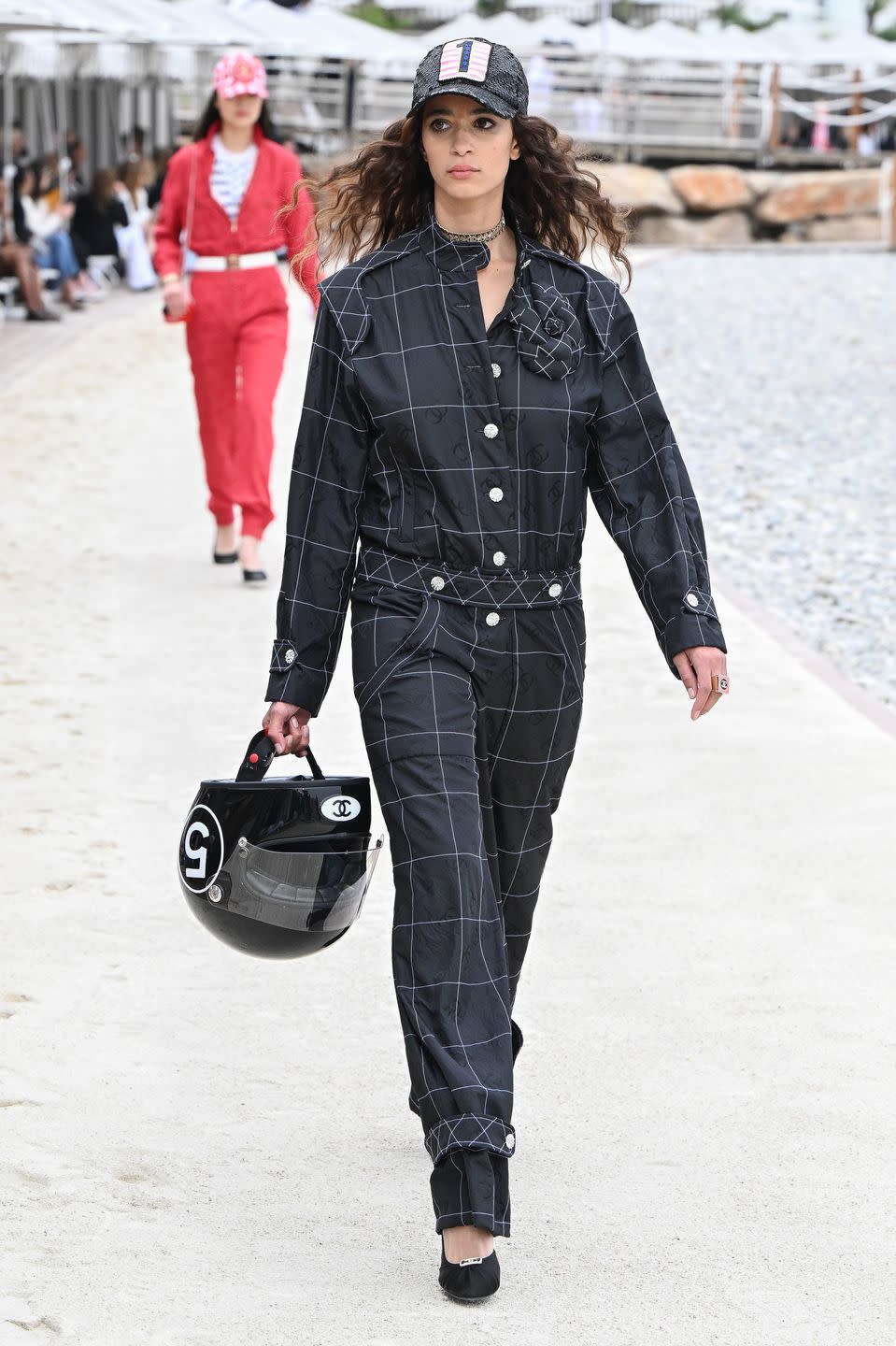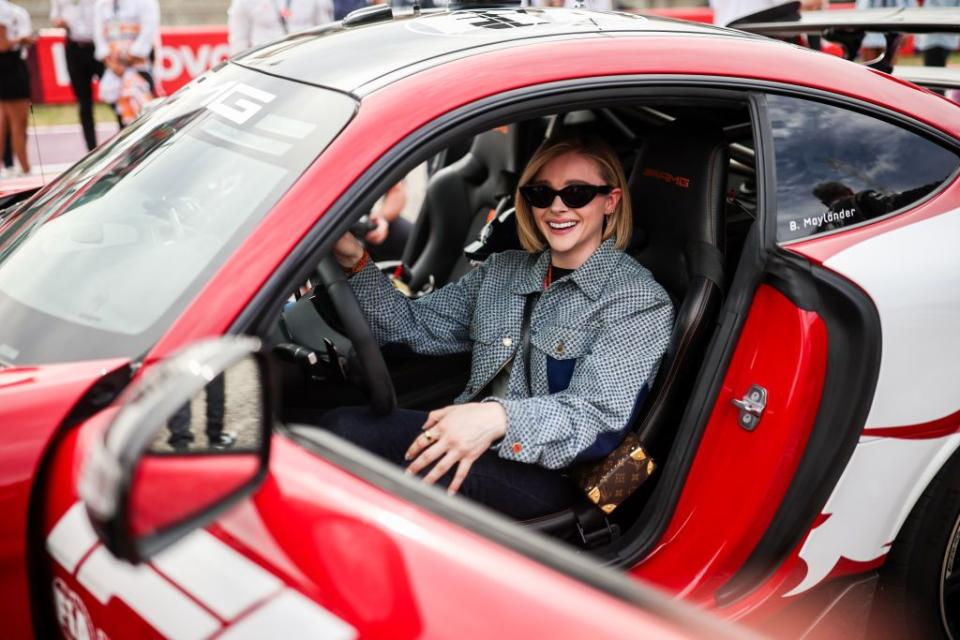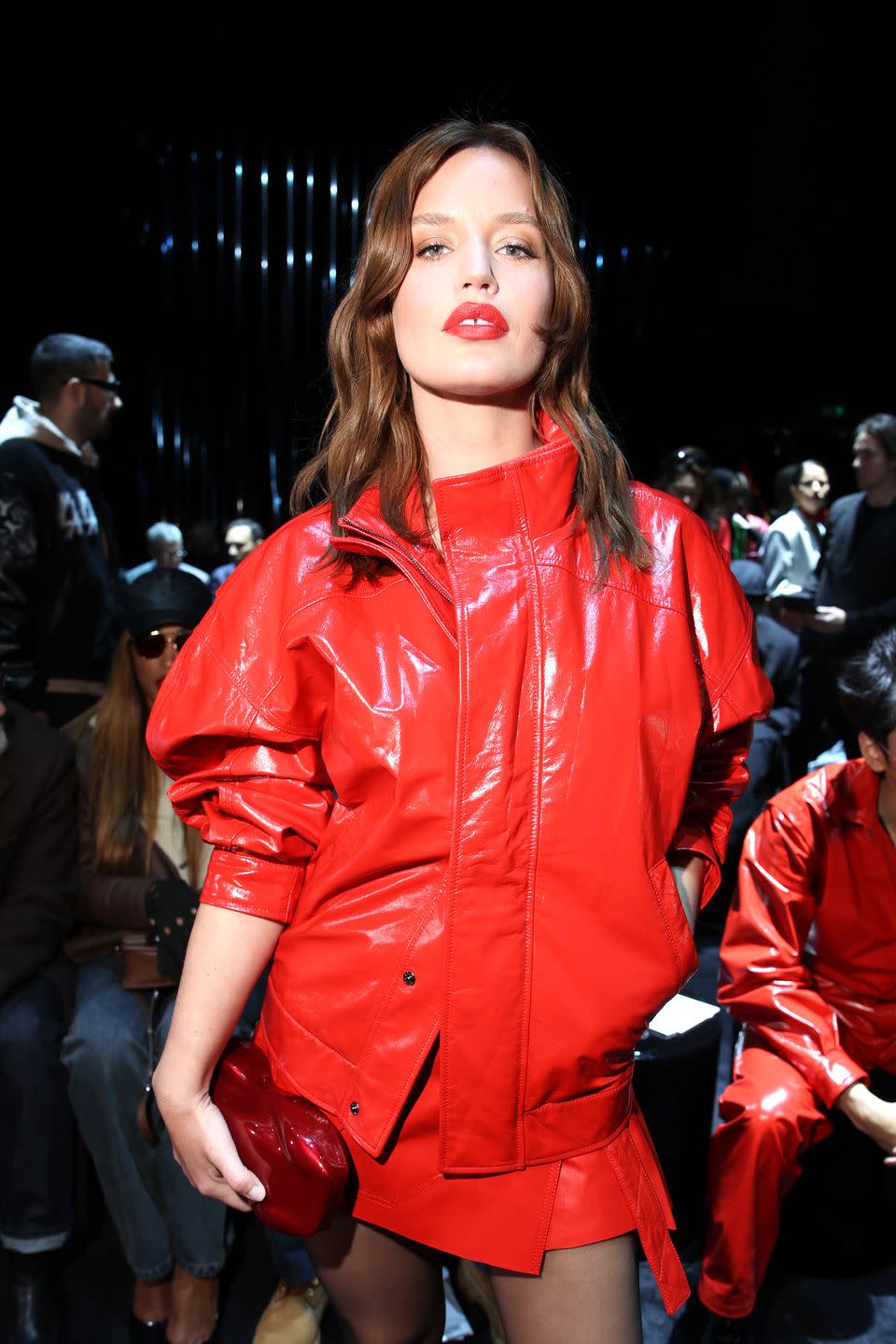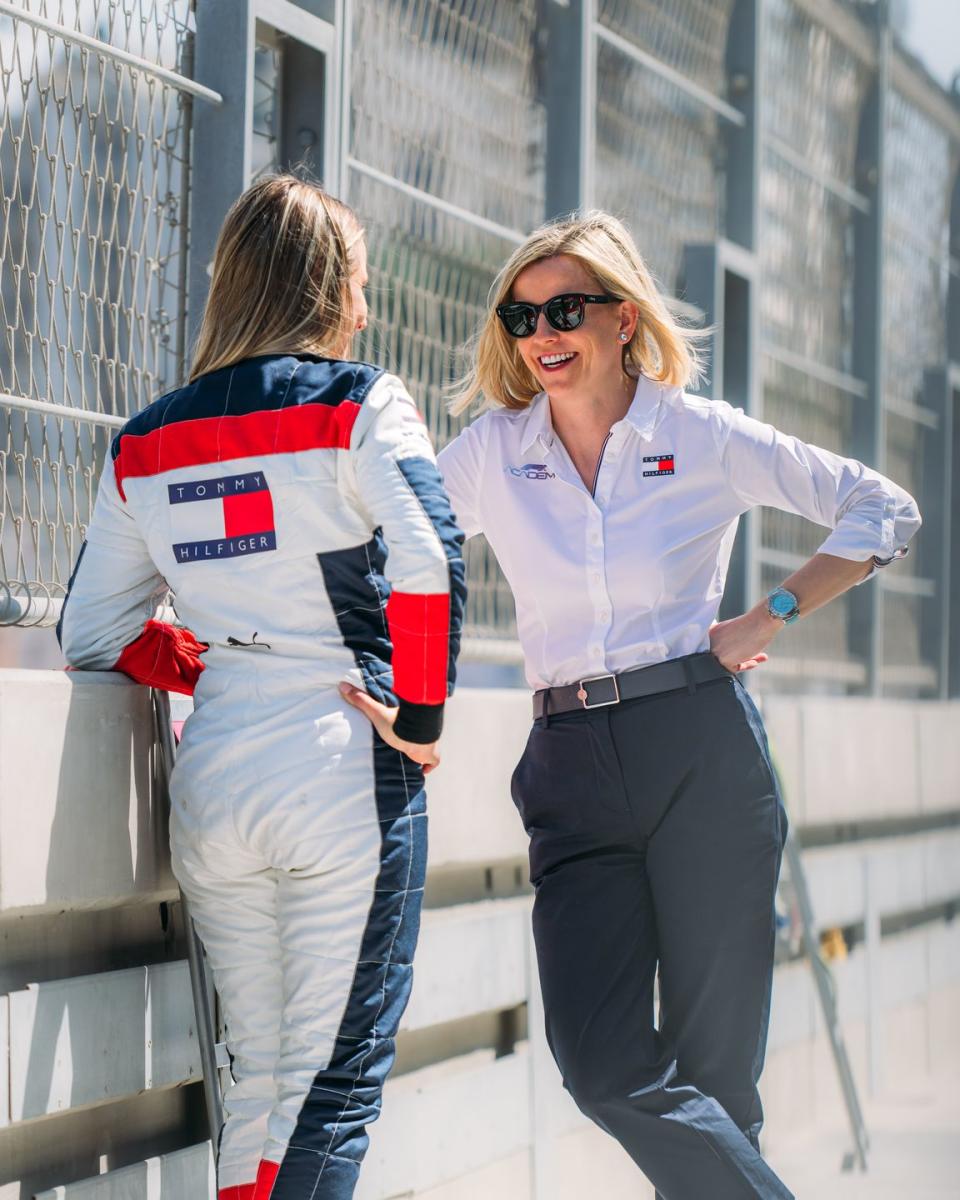Prijanka Chopra in The trompe l’oeil maxi dress from Y/Project a visit to the Ferrari garage. Lupita Nyong’o in Longchamp with checkered flag, alongside Red Bull driver Checo Perez. Marine Serre’s reconstituted racing suit dress, with armored bustier and bustle. Let alone, Chanel’s racetrack-inspired 2023 cruise collectioncomplete with Chanel No.5 helmets.
If says Lewis Hamilton“there was [once] a feeling that high fashion and high performance cannot coexist,” but of grid walk to enter celebrity street style, it’s clear that fashion’s motorsport moment is now in overdrive.

Trends come and go of course, but this sporty crossover is more than just references to the catwalk. Formula 1 and the fashion industry have suddenly developed an interest in each other that is as profitable as it is mainstream. According to a report by brand agency Karla Otto and insights specialists Lefty, Formula 1 is the second fastest growing sport contributing to fashion brands’ Earned Media Value (EMV), with a 35 percent increase in 2023. In other words, the marketing budgets spent within the F1 ecosystem are currently delivering a huge return on investment. Several column inches have already been spent trying to figure out why that might be the case. Most land on this formula: TikTok + Netflix + Hamilton = global marketing gold mine. And they’re not wrong.
Formula 1’s flying reality series Drive to survive has attracted more viewers 7 million. And (F1 owner) Liberty Media’s recent social media strategy – which includes encouraging drivers to have a much bigger presence across all platforms – means that paddock favorites, such as style maven Hamilton, now have personal followers up to 40 million. It’s no wonder brands are eager to capitalize on some of that fame. But the phenomenon deserves a closer look, because while the celebration of drivers is influential, it’s not necessarily the driving force (pun intended) behind this new relationship with fashion. The real reason luxury houses are flocking to the circuit is… women.
One of the biggest changes in Formula 1 over the past five years has been the interest and participation of women. From the introduction of exciting experts such as Naomi Schiff on Sky Sports, to promoting women such as Hanna Schmitz as a Principal Strategy Engineer, through to the young women racing in feeder series F1 AcademyWomen are finally everywhere in the Formula 1 industry.
“I’ve always said, ‘If you can see it, you can be it,’” says F1 Academy director Susie Wolff, “and in a male-dominated sport, women are finally seeing themselves represented.” This visibility on and around the circuit is of great importance for the involvement of women in a broader sense. “Female fans now account for 40 percent of F1’s total fan base,” Wolff continues. “They are not only getting involved in F1 as fans, but also building strong communities within it. That is what is now attracting the interest of a whole spectrum of new brands, including those in the fashion and beauty world.”
Formula 1 has always been synonymous with luxury; it’s a sport for the rich, with six-figure entry fees for aspiring athletes. The most famous race takes place in Monaco, among a crowd of yacht owners and tax haven billionaires. Premium brands such as Rolex, Moët & Chandon and Louis Vuitton forged an association with it a long time ago. However, the target demographic of these sponsorship partners has traditionally been affluent and male.
Since then, the customer profile has changed dramatically. Vuitton’s storyline within Formula 1 is wonderful proof of this. The brand started making a travel suitcase for the Monaco Trophy, celebrating the heritage and tradition of the races. A few years later, Vuitton dresses Hamilton in the latest funnel-neck nylon from Pharrell’s SS24 collection, hosts driver Pierre Gasly at the Cannes Film Festival and sends psychedelic patchwork leather racing jackets down the catwalk. By leaning harder on the opportunities and attracting the sport’s younger audience and growing female fan base, Vuitton has become the main beneficiary of Formula 1’s cultural influence in the fashion industry. this reportedly netted them more than $6 million in EMV.
Some F1 teams are aware of the importance of the gender shift and have adjusted their focus more quickly than others. Although Tommy Hilfiger has long been involved in Formula 1, with sponsorship dating back to the 1990s, Mercedes-AMG made the smart move to hire Hilfiger – one of the top luxury brands among women worldwide – to help spark women’s interest. Together they have produced a series of fashion-forward collections for men and women, including an upcoming capsule collaboration with streetwear brand Awake NY. “The increasing interest and involvement of women in F1 is exciting,” says Hilfiger. “It adds a new, fundamental dimension to motorsport. The engagement we see on our social channels proves that our consumers are interested, invested and engaged.”


In the second year of McLaren’s fashion partnership with Reissthe retailer made the decision to downsize production of simple replica team kits, making way for a brand new ‘Hype’ collection of directional streetwear, leather varsity jackets and silky two-piece sets. Most of Hype is billed as unisex, but some of it is purely in women’s clothing. “McLaren has seen a big increase in their female fan base over the years,” explains Alex Field, menswear director at Reiss. “We saw female fans personalizing or cropping official merchandise to represent their fashion attitude, so we made Hype the answer. It is our best-selling and most requested collection for them.”
In 2021, Ferrari launched its own in-house fashion line of women’s ready-to-wear and recently negotiated a spot at Milan Fashion Week. “F1 is the new red carpet. We see Rihanna, Adam Driver, Naomi Campbell and many more requesting access to the Ferrari paddock and we recently dressed Alicia Keys in a custom Ferrari suit,” says Ferrari Style creative director Rocco Iannone. Even Aston Martin has switched from Hackett to Boss, from a brand that caters exclusively to a male audience to one that also makes women’s clothing. The lesson here is that the merchandise market is much stronger among women, who have more powerful ’emotional’ relationships with their purchases. The brands that recognize female fans’ desire to show their team affiliation while getting a peek are reaping the rewards.
Nowhere is this opportunity more attractive than in America, where women’s interest in watching sports has exploded most energetically. A record total audience of almost 60 million women for example, are now watching the Super Bowl. In response, the US has dramatically increased its participation in Formula 1, with the biggest recent success story being the Miami Grand Prix, which started in 2022 and now has viewing figures of more than 1.2 million.
The special opportunities of the races in Miami and Las Vegas for brands lie not only in the many female fans and celebrities in attendance (even Michelle Obama shows up for the race weekends in Miami), but also in the emphasis on luxury consumption. With the global demand for luxury goods in flux, sales figures are increasingly dependent on the whims of the very wealthy. With basic ticket packages ranging from $700 to $10,000 for the Miami GP, the packed grandstands are clearly rich.


In addition to women monopolizing the luxury and merchandise markets, female fans are naturally becoming more interested in a sport that is finally starting to support their own. Indoor tracka report from the women’s motorsport initiative More than rightfound that 56 percent of female fans are more likely to purchase from brands that sponsor women. This means that labels like Tommy Hilfiger, Charlotte Tilbury and Puma, who loudly and proudly support the F1 Academy’s female racers, are making smart decisions for ROI.
“[Female fans] have strong opinions on what they see as the sport’s inability to look and feel more diverse,” said Ali Donelly, CEO of More Than Equal. “There are enormous opportunities for brands that are willing to invest in women.” “I believe it is our responsibility to use our platform to create change,” Hilfiger added. “Our partnership [with F1 Academy] marks a huge step towards equal access in Formula 1. And I believe that the intersection of fashion and motorsport is here to stay.”


In the race for relevance, Formula 1 and the fashion industry find a powerful ally in female fans. The success of this convergence is driven by women who bring both passion and purchasing power. And the alliance isn’t just about aesthetics, it’s about influence. Women spend with purpose and turn their financial power into a catalyst for change.
You might also like it